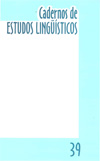Resumen
Morphologists working on Brazilian Portuguese have generally neglected the study of non-concatenative morphological operations, such as blending, acronym formation and truncation, perhaps influenced by the opinions of normative grammarians, who claim that these mechanisms of word-formation are arbitrary and unpredictable (cf. Basílio 1987, Sandmann 1991). In this paper, I will concentrate on blending (portmanteaus morphemes) in Brazilian Portuguese and show that the process involved in their creation are quite regular. A formal account of this phenomenon, involving both its morphological and phonological aspects, will be provided. The paper is organized as follows: in section I, I give a description of the phenomenon of blending, a discussion of its cross-linguistic relevance and of the way it is formally treated in the literature. In section II, I will sketch the essentials of Optimality Theory (Prince and Smolensky, 1993), more particular the version of OT know as Correspondence Theory (McCarthy and Prince, various publications), which will serve as the theoretical framework of my study. Section 3 discusses the general aspects and the constraints that are active in blending formation. Finally, section 4 contains the concluding discussion and some suggestion for the further research. It also contains a list of Brazilian Portuguese blending examples.
Citas
ARCHANGELI, Diana & LANGENDOEN, Terence. (1996). Optimality theory: as Overview. Oxford: Brasil. Blackwell.
BAT-EL, Outi. (1993). Selecting the best of the worst: the grammar of Hebrew blends. Phonology 13: 283-328.
BASÍLIO, Margarida. (1987). Teoria lexical. São Paulo: Ática.
BAUER, Laurie. (1983). English word-formation. Cambridge: Cambridge University Press.
BAUER, Laurie. (1988). Introducing Linguistic Morphology. Edinburgh: Edinburgh University Press
BISOL, Leda. (1998). Um estudo sobre a nasalidade. Campos do Jordão. Ms.
CARROLL, Lewis. (1996). The Complete Works. John Tenniel (ed.) Hertfordshire: Wordsworth Editions.
GOLDSMITH, John (1976). Autosegmental Phonology. New York: Garland [publicado em 1979].
GOLSTON, Chris. (1996). Direct Optimality: representation as pure markedness. Language 72, 713-48.
HACKEN, Pius ten. (1994). Defining Morphology. Zürich: Georg Olms Verlag.
HAMMOND, Michael. (1996). There’s no Lexicon! Ms.
JANDA, Richard. (1986). Overlapping morphemes. Berkeley: Berkeley Linguistic Society.
KENSTOWICZ, Michael. (1994). Phonology in Generative Grammar. Oxford: Basil Blackwell.
KELLY, Michael. (1998). To ‘brunch’ or to ‘brench’: some aspects of blend structure. Linguistics 36 (3): 579-590.
KIPARSKY, Paul. (1982). From Cyclic Phonology to Lexical Phonology in: Hulst, Harry van der. The Structure of Phonological Representations. Dordrecht: Foris.
LEE, Seung Hwa. (1992). Fonologia Lexical do Português. CEL 23. Campinas: IEL/Unicamp
LEE, Seung Hwa. (1996). Morfologia e fonologia lexical do português. Síntesesc1. Campinas: IEL/Unicamp.
MCCARTHY, John & Prince, Alan. (1993a). Prosodic Morphology in: Goldsmith, John. (1993). The Handbook of Phenological Theory. Oxforf: Basil Blackwell.
MCCARTHY, John & Prince, Alan. (1993b). Generalized Alignment. Yearbook of Morphology: 79-153.
MCCARTHY, John & Prince, Alan. (1995a). The emergence of the unmarked. Ms. Rutgers University.
MCCARTHY, John & Prince, Alan. (1995b). Faithfullness and reduplicative identity. Ms. Rutgers University.
PHARIES, David. (1987). Blending in spanish word formation. Romanistisches Tahrbuch 38.
PINEROS, Carlos. (1998).Prosodic Morphology in Spanish. Ms. The Ohio University.
PRINCE, Alan & Smolensky, Paul. (1993). Optimality Theory. Ms. Rutgers University/University of Colorado.
SANDMANN, Antônio. (1991).Competência Lexical. Curitiba: Editora da UFPR.
SPENCER, Andrew. (1991). Morphological Theory. Oxford: Basil Blackwell.
WILLIAMS, E. (1981). On the notions of ‘lexically related’ and ‘head of a word’. Linguistic Inquiry 12: 245-274.
Se otorgan a la Revista CADERNOS DE ESTUDOS LINGÜÍSTICOS todos los derechos de autor relativos a los trabajos publicados. No se devolverán los originales. En virtud de su aparición en esta revista de acceso abierto, los artículos son de uso gratuito, con la debida atribución, en aplicaciones educativas y no comerciales.

